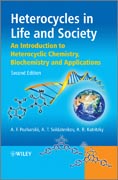
Heterocycles in life and society: an introduction to heterocyclic chemistry, biochemistry and applications
Pozharskii, Alexander F.
Katritzky, Alan R.
Soldatenkov, Anatoli
Heterocycles in Life and Society is an introduction to the chemistry of heterocyclic compounds, focusing on their origin and occurrence in nature, biochemical significance and wide range of applications. Written in a readable and accessible style, the book takes a multidisciplinary approach to this extremely important area of organic chemistry. Topics covered include an introduction to the structure and properties of heterocycles; the key role of heterocycles in important life processes such as the transfer of hereditary information, how enzymes function, the storage and transport of bioenergy, and photosynthesis; applications of heterocycles in medicine, agriculture and industry; heterocycles in supramolecular chemistry; the origin of heterocycles on primordial Earth;and how heterocycles can help us solve 21st century challenges. For this second edition, Heterocycles in Life and Society has been completely revised and expanded, drawing on a decade of innovation in heterocyclic chemistry. The newedition includes discussions of the role of heterocycles in nanochemistry, green chemistry, combinatorial chemistry, molecular devices and sensors, and supramolecular chemistry. Impressive achievements include the creation of variousmolecular devices, the recording and storage of information, the preparation of new organic conductors, and new effective drugs and pesticides with heterocyclic structures. Much new light has been thrown on various life processes, while the chemistry of heterocycles has expanded to include new types of heterocyclic structures and reactions, and the use of heterocyclic molecules as ionicliquids and proton sponges. Heterocycles in Life and Society is an essential guide to this important field for students and researchers in chemistry, biochemistry, and drug discovery, and scientists at all levels wishing to expand their scientific horizon. INDICE: PREFACE TO SECOND ENGLISH EDITION PREFACE TO FIRST ENGLISH EDITION1 MOLECULAR RINGS STUDDED WITH JEWELS 1.1 From Homocycle to Heterocycle 1.2 Building Heterocycles from Benzene 1.3 Some More Kinds of Heterocycles 1.4 Problems 1.5 Suggested Reading 2 WHY NATURE PREFERS HETEROCYCLES 2.1 Reactions forAll Tastes 2.2 Heterocycles as Acids and Bases 2.3 Heterocycles and Metals 2.4 There are Subtle Ties of Powerm' 2.5 Tautomerism: Heterocycles and Their Masks' 2.6 Problems 2.7 Suggested Reading 3 HETEROCYCLES AND HEREDITARY INFORMATION 3.1 Nucleic Acids 3.2 The Double Helix 3.3 How One DNA Doubles Itself 3.4 Protein Synthesis. Genetic Code and Genome 3.5 What are Mutations? 3.6 Mysterious Telomers 3.7 Gene Expression 3.8 Problems 3.9 Suggested Reading 4 ENZYMES, COENZYMES AND VITAMINS 4.1 Molecular Robots 4.2 Coenzymes and Enzymes as JointMolecular Ventures' 4.3 Vitamins, the Molecules of Health' 4.4 Ribozymes: Vestiges of an Ancient World 4.5 Problems 4.6 Suggested Reading 5 HETEROCYCLES AND BIOENERGETICS 5.1 ATP as the Universal Currency of Energy 5.2 Breathing 5.3 Problems 5.4 Suggested Reading 6 HETEROCYCLES AND PHOTOSYNTHESIS 6.1 Chlorophyll: Sunlight-receiving Antenna and Energy Carrier 6.2 What Daylight can Achieve 6.3 Photosynthesis without Light 6.4 Problems 6.5 Suggested Reading 7 HETEROCYCLES AND HEALTH 7.1 Medicines from a Natural Storehouse 7.2 Heterocycles versus Infectious Microbes 7.3 Heterocycles and Viral Infections 7.4 Heterocyclesand the Diseases of Our Century 7.5 Heterocyclic Molecules in Combat with Ulcer and Sexual Disfunctions 7.6 Problems 7.7 Suggested Reading 8 HETEROCYCLES IN AGRICULTURE 8.1 A Century of Chemical Warfare against Weeds 8.2 Regulators of Plant Growth 8.3 The Struggle against Voracious Insects 8.4 Resisting the Kingdoms of Mustiness and Rot 8.5 Heterocycles in Animal Husbandry 8.6 Combinatorial Chemistry and Functional Genomics in the Synthesis of Biologically ActiveHeterocyclic Compounds 8.7 Problems 8.8 Suggested Reading 9 HETEROCYCLES IN INDUSTRY AND TECHNOLOGY 9.1 Heterocycles and Natural Colors 9.2 Dyes 9.3 Fluorescent Agents 9.4 Color Change Compounds 9.5 Fire Retardancy 9.6 Photographic Materials and Recorders of Information 9.7 Heterocycles as Food Additives 9.8 Heterocycles as Cosmetics and Perfumery Ingredients 9.9 Other Applications 9.10Problems 9.11 Suggested Reading 10 HETEROCYCLES AND SUPRAMOLECULAR CHEMISTRY 10.1 Molecular Recognition and Host-Guest Interactions 10.2 Self-assembling Molecular Systems 10.3 Problems 10.4 Suggested Reading 11 HETEROCYCLES AND 21st CENTURY CHALLENGES 11.1 Energy Problems 11.2 Ecology and Green Chemistry 11.3 Biotechnology and Related Problems 11.4 From Molecular Devices to Molecular Computer 11.5 Problems 11.6 Suggested Reading 12 THE ORIGIN OF HETEROCYCLES 12.1Origin of the Universe and Appearance of Chemical Elements 12.2 Iterstellar Molecules 12.3 Organic Compounds in Comets and Meteorites 12.4 Do Heterocycles exist on the Moon an
- ISBN: 978-0-470-71411-9
- Editorial: John Wiley & Sons
- Encuadernacion: Cartoné
- Páginas: 376
- Fecha Publicación: 01/04/2011
- Nº Volúmenes: 1
- Idioma: Inglés
